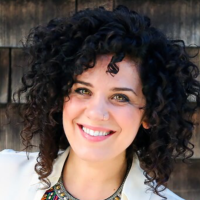Students Are Central to Solving the World's Gravest Challenges

EDITOR’S NOTE: Maria Tranquilli is the new Executive Director of the Common Mission Project, an international organization that engages students, educators, government organizations, and the private sector in solving the world’s gravest problems in national security, natural disasters, energy, and the environment. CMP is the nonprofit arm of innovation company BMNT. It delivers the curriculum and educator training for Hacking4Defense, the global academic course that has transformed how national security challenges are solved. Tranquilli has over 20 years of experience at the intersection of innovation, entrepreneurship and defense. In this Q&A with EIX she shares her thoughts about building the next generation of innovators.
Q: What have your years in the defense industry taught you about innovative thinking and strong partnerships?
My journey through the defense industry, enriched by my experience as a STEM educator, has underscored that innovation is not just a goal—it's a mission-critical imperative. The most powerful innovations emerge at the intersection of academia, government, and the private sector. These partnerships aren’t just collaborative—they’re crucial to securing our future.
Every day, we face rapidly evolving threats that demand not just new ideas but transformative thinking. I’ve seen firsthand that no single entity, no matter how well-resourced, can tackle these issues alone. By convening academia, government, and private industry, however, we discover the most effective and lasting solutions. The urgency to innovate, to push the boundaries of what’s possible, drives me—and it’s what makes strong, cross-sector partnerships indispensable.
Educators play a pivotal role in this ecosystem, shaping the next generation of leaders and problem-solvers. Their role in fostering innovation is vital to our collective security and success.
Q: How are defense problems going to become more challenging in the future? Why is it important to cast a wide net for solutions, even beyond defense industry professionals?
As global dynamics continue to evolve, the complexity of defense problems will only intensify, driven by rapid advancements in technologies such as cyber security, artificial intelligence, and unmanned systems. These challenges extend far beyond the military realm, affecting every layer of our national and international frameworks, from economic stability to social cohesion. Given the multifaceted nature of these issues, it's imperative to cast a wide net for solutions, reaching beyond the traditional defense industry to include diverse perspectives from various disciplines. Bringing in unconventional voices and expertise challenges the status quo and fosters innovation that can push beyond traditional boundaries. This inclusive approach ensures that our solutions are not only innovative but also sustainable and resilient, capable of addressing the broad spectrum of challenges we face both now and in the future – and students are at the heart of it
Q: Why is it important to involve students, who are still learning and inexperienced, in solving real-world defense problems?
Involving students in real-world defense challenges is not just beneficial—it’s essential. Students are the most vital element of our ecosystem, bringing it to life with their energy, creativity, and willingness to challenge the status quo. Engagement with complex problems provides these rising leaders and future executives with crucial hands-on experience. Their fresh, uninhibited perspectives are often the catalysts for innovative solutions that might elude more seasoned professionals. By immersing them in the depths of critical national security issues now, we are not only enhancing their educational experience but also preparing them to be the informed and capable guardians of our nation’s future security. The vibrancy and dynamism they bring into the Hacking for Defence® (H4D) ecosystem are what make it extraordinarily effective and impactful.
Q: How is H4D transforming entrepreneurial education? How has it helped professors engage students more deeply?
H4D has fundamentally transformed entrepreneurial education by creating a vibrant ecosystem where government problem sponsors, industry mentors, and university communities converge. Taught in over 60 U.S. universities, as well as in the UK and Australia – and growing! – the model adopts a flipped classroom approach, enabling direct engagement with real-world challenges through live, rigorous conversations and hands-on problem-solving.
Professors tell us that this approach not only increases student engagement but fosters a more profound commitment to their education and the real problems they are solving. As students interact with a diverse range of experts and peers, they see the immediate impact of their contributions, further fueling their drive to innovate. In fact, we see that 35% of H4D alumni go on to work in the public sector in some capacity within 2 years of engaging with our programs. More than 60 student teams have formed dual-use companies around the solutions they developed in class.
As we continue this work, we ensure the preservation of our greatest asset amongst a new generation: the spirit of American innovation and entrepreneurship. This spirit is vital as we empower the next generation of problem-solvers to address the toughest issues facing our country and our international allies, protecting and promoting entrepreneurship as a cornerstone of American identity and economic vitality.
Q: How can H4D curricula be strengthened to help students develop their innovation skills even more?
To further enhance the H4D curriculum and bolster our students' innovation skills, we continue to refine our use of the Lean Startup methodology, specifically adapted to address mission-driven problems. This approach encourages students to dive deep into the entrepreneurial process by directly confronting the challenges and frictions inherent in solving real government problems. The new Hacking for Defense® Manual, publishing later this month, is a cornerstone in this effort, a companion textbook for the course that encapsulates best practices and innovative methodologies, including our adapted Lean principles.
Additionally, our flipped classroom model immerses students in hands-on experiences, simulating the entrepreneurial environment and enhancing their problem-solving capabilities. By integrating these elements—tailored Lean methodology, a comprehensive manual, and experiential learning—we equip our students to address complex issues with agility and creative insight.
Q: How does getting involved in H4D prepare students for jobs after graduation, both inside and outside the defense industry?
Involvement in H4D equips students with critical thinking, problem-solving, and entrepreneurial skills that are highly sought after in any industry. These competencies, honed through addressing real-world challenges, make our students exceptionally valuable to potential employers. Furthermore, the robust network and strong reputation students build during their coursework in H4D often lead to significant opportunities for career advancement. Student tech teams that complete the course often go on to build companies based around the work. In some cases, they are admitted to the H4XLabs enterprise accelerator run by innovation company BMNT or similar programs. One group this year – Usul out of Stanford – was accepted to tech accelerator YCombinator. In other cases, we’ve seen students go on to work in government. These student achievements underscore the practical impact and the high level of preparedness our students attain, preparing them to be leaders in both public and private sectors.
Q: What are your goals for the CMP and making it even stronger?
Our nation's security challenges demand bold, innovative solutions, and I am committed to pushing the boundaries of what's possible. By expanding our Fund, strengthening our programs, and scaling our top-tier alumni talent network, we will empower the next generation of problem solvers to tackle the toughest issues facing our country and our international allies. Together, we'll ensure the preservation of our greatest asset amongst a new generation: the spirit of American innovation and entrepreneurship.
To learn more about H4D or sign up for one of its educators’ courses, visit https://www.commonmission.us/ or email [email protected].





